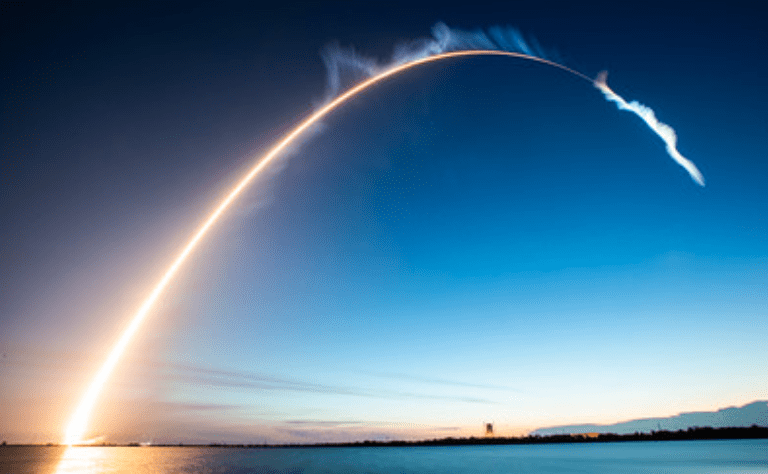Latest News

A ULA Atlas V rocket carrying the AEHF-5 mission for the U.S. Air Force Space and Missile Systems Center lifts off from Space Launch Complex-41 at 6:13 a.m. ET on Aug. 8, 2019. Photo: United Launch Alliance
Delays are surfacing in planned U.S. Space Force (USSF) missions under the National Security Space Launch (NSSL) program.
USSF has said that its first Falcon Heavy launch is to be for the classified USSF-44 mission, which is to carry two payloads–a TETRA-1 prototype Geostationary Orbit (GEO) satellite and a larger satellite. But the launch has slipped from July until October.
“USSF-44 launch date is slipping from July, 2021 to October, 2021 to accommodate payload readiness,” per a May 19 email from Col. Robert Bongiovi, director of Space and Missile Systems Center‘s (SMC) Launch Enterprise.
SpaceX, headed by tech billionaire Elon Musk, builds the Falcon Heavy rocket, which the company has said doubles the lift capacity of the United Launch Alliance (ULA) Delta IV Heavy rocket. Falcon Heavy has three Falcon 9 cores with nine engines each to allow Falcon Heavy to carry up to 141,000 pounds. SpaceX received a $297 million contract for three launches, including the USSF-44 mission, in February, 2019.
Last Aug. 7, under Phase 2 of NSSL, SMC, in partnership with the National Reconnaissance Office, awarded ULA $337 million for two classified launches in 2022–USSF-51 and USSF-106, and SpaceX a $316 million contract for one classified mission launch–USSF-67.
USSF and SpaceX have not disclosed the reason or reasons why the SpaceX contract for USSF-67 is double the unit launch cost of the ULA USSF-51 and USSF-106 missions. SpaceX’s Falcon 9 and Falcon Heavy launches start around $60 million but will cost no more than $150 million, Musk has said.
ULA’s Vulcan Centaur rocket — a successor to the ULA Delta IVs and Atlas Vs— is to power the USSF-106 mission into orbit.
Space Force had said USSF-51 would be its first mission to be carried aloft by the ULA Vulcan Centaur in the second quarter of next year. Now SMC says it that the first Vulcan launch for USSF will be on USSF-106 in 2023, as the Atlas V will carry the USSF-51 payload.
“The SMC Launch Enterprise worked with United Launch Alliance (ULA) to change the USSF-51 launch vehicle configuration, at ULA’s request, on the Phase 2 contract from a Vulcan Centaur to an Atlas V to mitigate schedule risk associated with Vulcan Centaur non-recurring design validation,” according to Bongiovi’s May 19 email. “The Phase 2 contract allows for consideration of a secondary launch vehicle to mitigate schedule risk only in the first two (fiscal 2020 and fiscal 2021) ordering periods at the same fixed price as the original launch vehicle. SMC Launch Enterprise has assessed the launch vehicle configuration change to an Atlas V launch vehicle as low risk and a viable solution.”
ULA said on May 19 that USSF and the alliance have agreed to switch the planned rocket for USSF-51 from Vulcan Centaur to the existing Atlas V in order to provide more development time for the Vulcan Centaur.
“USSF-51 will fly on an Atlas V,” per a May 19 email from ULA. “USSF-51 is similar to other missions previously flown by Atlas. By utilizing Atlas, efficiencies can be gained for the payload provider as well as in launch mission planning and integration. ULA’s Phase 2 contract contains provisions for an Atlas to fly missions in place of the less expensive Vulcan Centaur without cost penalty to the government. ULA proposed changing USSF-51 from a Vulcan Centaur to an Atlas by submitting a formal letter of request to the USSF, and they agreed with the merits of these benefits. This also increases schedule margins between Vulcan Centaur’s certification flights and its first National Security Space mission, providing the best overall value to the mission.”
The first three NSSL Phase 2 missions are to launch between FY 2022 and FY 2024, and SMC is to order launch services annually from ULA and SpaceX for up to 34 launches over five years. ULA is to receive 60 percent of the launch orders, and SpaceX will receive the remaining 40 percent.
Congressional appropriators are concerned with the cost of NSSL, as the Evolved Expendable Launch Vehicle program, the predecessor to NSSL, had as its paramount goal a dramatic reduction in launch costs through lower cost commercial launch providers.
Northrop Grumman and Blue Origin lost out in the Phase 2 NSSL awards. While the U.S. Air Force said that it did not pay termination costs to Northrop Grumman and Blue Origin for ending their Launch Service Agreement Other Transaction Authority pacts last Dec. 31, the service did pay the companies more than $787 million for meeting milestones in the more than two years the companies spent developing their launch systems–OmegA for Northrop Grumman and New Glenn for Blue Origin. The Air Force paid $531.7 million to Northrop Grumman and $255.5 million to Blue Origin.
This article was originally published by our sister publication Defense Daily.
Get the latest Via Satellite news!
Subscribe Now